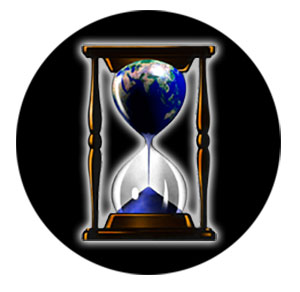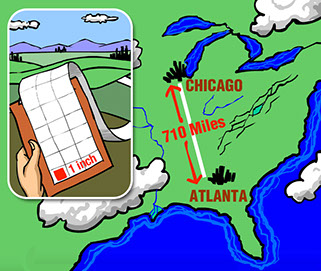
MENU

Earth's Age
Over the last 100 years the assumed age of the earth has doubled roughly every twenty years as our understanding of the complexity of living things has progressed. For evolutionists, if things begin to seem illogical, the addition of more time can solve the problem.
Many methods can be used to determine the age of the earth. Several systems known as radiometric dating are widely accepted by macroevolutionists. Because a radioactive element such as uranium (the parent element) decays at a known rate into lead (the daughter element), it is believed that scientists can determine the actual age of the rock in which it is found. Scientists measure the proportion of the parent element to the daughter element to determine the age of the rock containing the radioactive material. Major weaknesses inherent in this system are rarely explained even though evolutionists like to refer to them publicly as “absolute dating methods.” However, as evolutionist William Stansfield of California Polytech State points out:
It is obvious that radiometric techniques may not be the absolute dating methods that they are claimed to be. Age estimates on a given geological stratum by different radiometric methods are often quite different (sometimes by hundreds of millions of years). There is no absolutely reliable long-term radiological “clock.”1
Some of the problems with “absolute dating” include the facts that:
- They sometimes contradict each other by hundreds of millions of years.
- They give ages that are wrong by millions of years when tested on rocks of known age.2
- They are based on unproven and unreasonable assumptions (as explained below).
Unproven and Unreasonable Assumptions
Because radiometric methods claim to be measuring such extremely large periods of time, they are particularly affected by the following assumptions:
- Known Original Setting: Radiometric dating assumes that the “clock” was set at “zero” in the beginning or that the original setting can somehow be known. Evolutionists assume that only the “parent” element and none of the “daughter” element was present in the original material. But in reality, there is no way this can be known.
- Known Run Rate: Radiometric dating assumes that the “clock” (decay rate) always ran at the same pace. It never stopped, slowed down, ran faster or backed up. The rate of decay from the parent element to the daughter element is assumed to have always happened at the same rate at which we observe it happening today. This is an unreasonable assumption because “chemical processes occurring in nature are capable of systematic removal of either lead or uranium,” profoundly affecting the dates given by this radiometric method.3 Additionally, radiometric measurements have been made for only about 100 years; therefore, it is unreasonable to assume (see Huge Assumption) that the rates of decay have remained constant for billions of years.4
In 1982, evolutionist Frederick B. Jueneman published some observations that probably haven’t been repeated on any PBS specials or included in any textbooks:
The age of our globe is presently thought to be some 4.5 billion years, based on radio-decay rates of uranium and thorium. Such “confirmation” may be short lived, as nature is not to be discovered quite so easily. There has been in recent years the horrible realization that radio-decay rates are not as constant as previously thought, nor are they immune to environmental influences. And this could mean that the atomic clocks are reset during some global disaster, and events which brought the Mesozoic to a close may not be 65 million years ago, but rather, within the age and memory of man.5
Although ignored by evolutionists because of their implications, there are many methods of determining the age of the earth which suggest an age far younger than 4.5 billion years.6 Several examples of these methods include:
- The earth’s shrinking magnetic field
- The low level of helium in earth’s atmosphere
- The amounts of various dissolved chemicals in the oceans
- The erosion rates of the continents
- The sedimentation rates in the oceans
A truly honest (not to mention scientific) approach to dating methods would be to consider all the data as well as explain the weaknesses inherent in the methods. Are evolutionists’ favorite methods of dating rocks really “absolute”? Absolutely not!

Huge Assumption
Let’s develop a mental picture of how large an assumption we are expected to accept with radiometric dating. First, let the 100 years during which scientists have been able to actually measure radiation be represented by a bar one inch long. The bar representing 4.5 billion years—the length of time over which evolutionists think it’s reasonable to extrapolate or extend the findings of the 100-year period—would be 710 miles long! That’s one inch compared to 710 miles (the distance from Atlanta, GA, to Chicago, IL)!

- William D. Stansfield, Ph.D., Biology Department, California Polytechnic State University as quoted in Taylor, Paul S. The Illustrated Origins Answer Book (Mesa, Arizona: Films For Christ Association, 1989), p. 13.
- Robert E. Kofahl and Kelly L. Seagraves, The Creation Explanation (Wheaton, IL: Harold Shaw Publishers, 1975), pp. 200-203.
- McDowell, Josh and Don Stewart. Reasons Skeptics Should Consider Christianity. (El Cajon, CA: Creation-Life Publishers, 1981), p. 111.
- Kofahl and Seagraves, p. 196.
- Frederic B. Jueneman, “Secular Catastrophism,” Industrial Research and Development, Vol. 24 (June 1982), p. 21, as cited in Taylor, p. 62.
- Morris, John D., The Geology Book. (Green Forest, AR: Masters Books, 2000), p. 54-57.
Design, graphics and artwork copyright © 2016 Tim Beasley • All rights reserved.